#Karoo Supergroup
Explore tagged Tumblr posts
Text
You know what time it is!
It's Karoo Supergroup time!
*plays Africa by Toto*
#my posts#The Common Descent Podcast#Common Descent#Karoo Supergroup#Africa#geology#their will be synapsids in this one#Permian#Triassic#also catches some Carboniferous and Jurassic#podcast
3 notes
·
View notes
Text
Tapinocaninus

Tapinocaninus was a genus of tapinocephalid therapsid from the Middle Permian. Its type and only species is T. pamelae. Its known specimens were found in the Karoo Supergroup in South Africa. Tapinocaninus is the largest known therapsid from the Guadalupian Period.
The generic name Tapinocaninus means humble (tapino) canine (caninus). The specific name pamelae was named for Pam Rubridge, the mother of the original describer, Bruce S. Rubridge. She was on the field when he discovered the first fossils.
Most known Tapinocaninus fossils consist of skulls, though its spine of 36 vertebrae, several ribs, pectoral and pelvic girdles, three humeri, and a femur have been discovered. Its autapomorphies include a relatively large temporal opening, only having two sacral vertebrae, only seven caudal vertebrae, a notably high amount of vertebral intercentra, an anterior coracoid included in the glenoid, which is straight and facing posteroventrally, and the lack of ectepicondylar foramen.
Tapinocaninus has been recovered as the most basal member of Tapinocephalidae, as it has both derived dinocephalian features and ancestral features of sphenacodonts. Tapinocephalidae itself is the most derived family of Dinocephalia.
Original paper: Rubridge 1991, Postcranial materials description 2019
Wikipedia article: here
#tapinocaninus#tapinocanininae#tapinocephalidae#dinocephalia#therapsida#therapsids#paleoart#paleontology#original art#human artist#artwork#obscure fossil animals#obscure fossil therapsids
17 notes
·
View notes
Photo

So I've spent the past week obsessing over the Vredefort Dome in South Africa; a remnant of the world's largest confirmed impact structure.
It was created by a ~10 mile wide asteroid ~2 billion years ago. The rocks uplifted at the centre of the crater (which was almost 200 miles across) are therefore extremely old and resilient to weathering, today represented by an arc of hills to the south west of Johannesburg.
Here is what the dome may have looked like during the Triassic Period. Essentially similar to today, but a bit taller. The south western portion and centre of the dome may have already been eroded away by then, since today those parts are overlain by the Permian aged Ecca Group (part of the Karoo Supergroup).
#asteroid#paleontology#dinosaur#south africa#geology#triassic#paleoart#scientific illustration#acrylic painting#dinosaur art#earth history
93 notes
·
View notes
Text
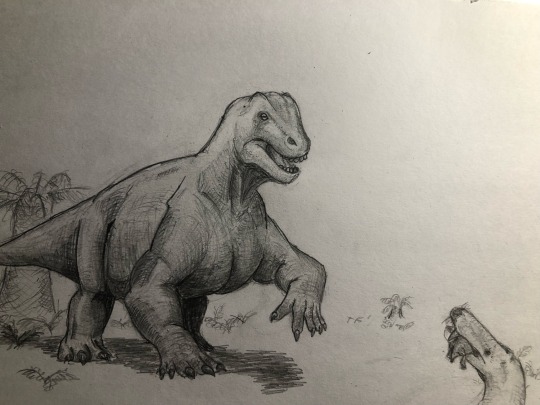
DINOVEMBER DAY 7: 260MYA, CAPITANIAN STAGE; SOUTH AFRICA
(Yeah no I'm not getting day 8 done tonight. Looks like another double installment tomorrow. Well. Today. It's 4am)
The Karoo supergroup of South Africa will have one of the best terrestrial fossil records in the world for the time period that it represents, starting in the middle Permian and ending in the early Jurassic. The sediments being laid down on the floodplain at the moment will, in modern times, become the older strata in the supergroup. For now, however, this is a battleground.
It is the Moschops' breeding season, and this 1-tonne bull is extra aggressive due to his raised testosterone levels. He stamps his powerful forelimbs and shakes his head at the target of his challenge, bellowing all the while, in an attempt to scare them off. Unfortunately, he has focused his effort on an unsuspecting Pristerognathoides, who has just removed her head from a Cistecephalus burrow with the burrow-owner clamped firmly between her jaws. All of these animals are synapsids, specifically, they are part of a group called the therapsids who have radiated out to fill a variety of ecological niches. There are three main groups of therapsid; the dinocepahlians, big barrel-chested, thick-headed animals, some of whom are bearlike omnivores, while others like Moschops are more specialised herbivores; the anomodonts, like Cistecephalus, squat pig-lizard-like animals with tusks and beaks; and the theriodonts, a group of more specialised carnivores like Pristerognathoides, generally small bodied at this time, but more active than the big dinocephalian predators.
The Pristerognathoides will flee as soon as she can, and soon the bull Moschops will be back to rutting, throwing his weight against other males and battering them with his thick skull. As the Pristerognathoides feeds on her anomodont prize, you might notice her enlarged, distinctly mammal-like, canine teeth. This is one of numerous ways she is more mammalian than her compatriots; she is also more endothermic, and her scales are beginning to become fur. Sure enough, theriodonts like her will eventually, after another 30-40 million years, give way to true mammals.
15 notes
·
View notes
Text
Euskelosaurus browni
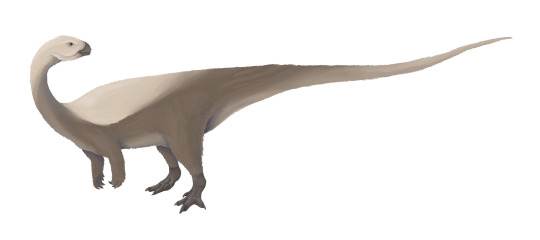
By Jack Wood
Etymology: Good Leg Reptile
First Described By: Huxley, 1866
Classification: Dinosauromorpha, Dinosauriformes, Dracohors, Dinosauria, Saurischia, Eusaurischia, Sauropodomorpha, Bagualosauria, Plateosauria, Plateosauridae
Status: Extinct
Time and Place: Around 210 to 205 million years ago, from the Norian to the Rhaetian ages of the Late Triassic

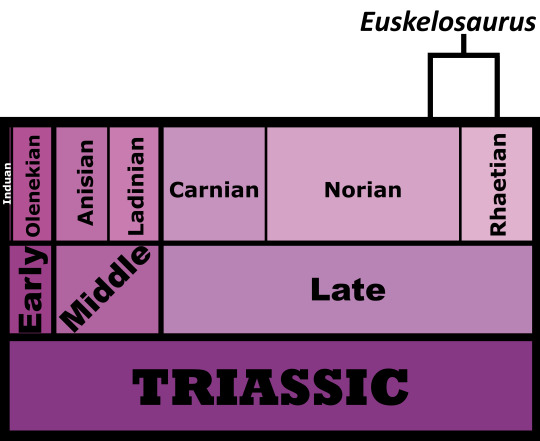
Euskelosaurus is known from the lower Elliot Formation of South Africa
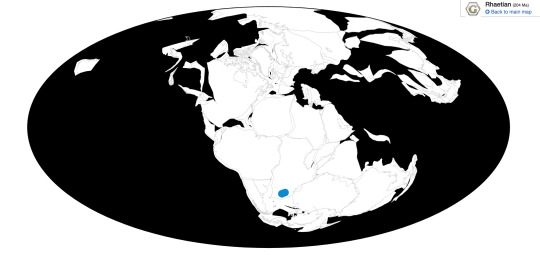
Physical Description: Euskelosaurus would have been a somewhat large, robust early sauropodomorph, possibly ten meters in length. It probably would have had long arms with long claws on the fingers, but they wouldn’t have had long enough arms to reach the ground. Euskelosaurus would have also had robust legs and a long tail. Its neck would have been long, ending in a small head. It might have been covered in some sort of fluffy covering, though we can’t be sure. It probably would have been quite heavy in general.
Diet: Euskelosaurus would have probably been an herbivore, most likely a mid-level browser.
Behavior: It is difficult to say exactly what the behavior of Euskelosaurus would have been, given it’s known from kind of poor remains. However, we can guess some things. Based on relatives like Massospondylus and the dinosaur family tree in general, it probably took care of its young. Based on other prosauropods, it probably lived in herding groups. And, given its size, it probably spent most of its time eating plant food. It also would have been active and warm-blooded, but not very fast. It’s claws could have been used to strip leaves off of branches, and its small head would have been able to weave in between dense foliage.
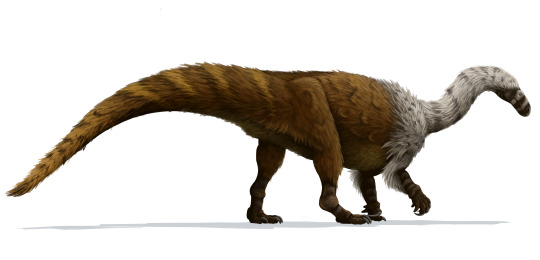
By Scott Reid
Ecosystem: Euskelosaurus lived in the Elliot Formation, a famous fossil ecosystem of Triassic to Early jurassic age animals showcasing how life evolved around the Triassic-Jurassic extinction and how dinosaurs began to explode into new forms right after the extinction. Unfortunately, Euskelosaurus hails from the early part of that ecosystem - the more poorly known Triassic member, where dinosaurs are few and far between, as are other animals. This makes Euskelosaurus important, being one of few dinosaurs known from this ecosystem, but also explains its poor condition. This was a semi-arid floodplain and lake system, with very long dry seasons and flash-in-the-pan wet seasons. It was primarily filled with conifers, as well as some horsetails and cycads.
It’s difficult to say exactly what animals Euskelosaurus lived with, given that the organization of the formation is murky and there are animals that are actually in the Upper Elliot Formation that were originally said to be in the Lower. However, Euskelosaurus probably lived alongside other Sauropodomorphs, including Eucnemesaurus, Plateosauravus, Blikanasaurus, and maybe others. There would have also been cynodonts, weird crocodile relatives, and even predatory dinosaurs. Until more is sorted out, however, it’s difficult to say.
Other: Euskelosaurus was a prosauropod, a type of dinosaur from which the larger sauropods would evolve at the end of the Triassic. It seems to be closely related to the better known Plateosaurus.
~ By Meig Dickson
Sources under the Cut
Bordy, E.M.; Eriksson, P. (2015-09-01). "LITHOSTRATIGRAPHY OF THE ELLIOT FORMATION (KAROO SUPERGROUP), SOUTH AFRICA". South African Journal of Geology. 118 (3): 311–316.
Broom, R. (1911). "On the dinosaurs of the Stormberg, South Africa". Annals of the South African Museum. 7: 291–308.
Cooper, M.R. (1980). "The first record of the prosauropod dinosaur Euskelosaurus from Zimbabwe". Arnoldia Zimbabwe. 9 (3): 1–17.
Durand, J.F. (2001). "The oldest juvenile dinosaurs from Africa". Journal of African Earth Sciences. 33 (3–4): 597–603.
Galton, Peter M. (1985). "Notes on the Melanorosauridae, a family of large Prosauropod Dinosaurs (Saurischia: Sauropodomorpha)". Geobios. 18 (5): 671–676.
Gauffre, Francois-Xavier (1993). "Biochronostratigraphy of the Lower Elliot Formation, southern Africa) and preliminary results on the Maphutseng dinosaur. Saurischia: Prosauropoda) from the same Formation of Lesotho". In Lucas, Spencer G.; Morales, Michael (eds.). The Nonmarine Triassic: Bulletin 3. pp. 147–9.
Huxley, TH (1866). "On the remains of large dinosaurian reptiles from the Stormberg mountains, South Africa". Geological Magazine. 3: 563–4.
McPhee, Blair Wayne (2016). The South African Mesozoic: advances in our understanding of the evolution, palaeobiogeography, and palaeoecology of sauropodomorph dinosaurs (Thesis).
McPhee, Blair W.; Choiniere, Jonah N. (2016). "A hyper-robust sauropodomorph dinosaur ilium from the Upper Triassic–Lower Jurassic Elliot Formation of South Africa: Implications for the functional diversity of basal Sauropodomorpha". Journal of African Earth Sciences. 123: 177–184.
McPhee, B. W., E. M. Bordy, L. Sciscio, J. N. Choiniere. 2017. The sauropodomorph biostratigraphy of the Elliot Formation of Southern Africa: Tracking the evolution of Sauropodomorpha across the Triassic-Jurassic boundary. Acta Palaeontologica Polonica 62 (3): 441 - 465.
Sciscio, Lara; De Kock, Michiel; Bordy, Emese; Knoll, Fabien (2017-11-01). "Magnetostratigraphy across the Triassic-Jurassic boundary in the main Karoo Basin". Gondwana Research. 51: 177–192.
Seeley, H.G. (1894). "XLI.—On Euskelesaurus Brownii (Huxley)". Annals and Magazine of Natural History. 14 (83): 317–340.
Tankard, Anthony; Welsink, Herman; Aukes, Peter; Newton, Robert; Stettler, Edgar (2009-09-01). "Tectonic evolution of the Cape and Karoo basins of South Africa". Marine and Petroleum Geology. 26 (8): 1379–1412.
Van Heerden, J. (1979). The morphology and taxonomy of Euskelosaurus (Reptilia: Saurischia: Late Triassic) from South Africa. Nasionale Museum.
Welman, Johann (1999). "The basicranium of a basal prosauropod from the Euskelosaurus range zone and thoughts on the origin of dinosaurs". Journal of African Earth Sciences. 29 (1): 227–232.
Yates, A.M. (2004). The death of a dinosaur: dismembering Euskelosaurus. Geoscience Africa. p. 715.
#Euskelosaurus#Euskelosaurus browni#Prosauropod#Dinosaur#Sauropodomorph#Palaeoblr#Factfile#Dinosaurs#Triassic#Africa#Herbivore#Mesozoic Monday#paleontology#prehistory#prehistoric life#biology#a dinosaur a day#a-dinosaur-a-day#dinosaur of the day#dinosaur-of-the-day#science#nature
184 notes
·
View notes
Photo

Today was an absolutely superb #geology day on our #namibia trip. We saw a #petrifiedforest , #snowballearth dropstones, the #twyfelfontein #worldheritagesite rock engravings, foliated granite and the oldest rock of our trip. Pics 1-4 show 270ma #permian petrified trees which grew in cold humid conditions and were up to 30m high. The trees are contained within fluvial sediments of the Karoo supergroup. Pics 5&6 show dropstones: pebbles that were dropped out of iceshelves or icebergs in Snowball Earth 630ma a time when the whole planet was glaciated. These pebbles were then stretched and deformed as the Damara mountains uplifted. Pic 7 shows a syntectonic granite with large feldspar crystals orientated to the stress field. The granite is around 600ma. Pics 8 and 9 are from the Twyfelfontein WHS and are between 4 and 8 thousand years old. Pic 8 is the most famous is the 'Man-lion' Pic 9 shows a giraffe but also a furseal and penguin showing the people travelled to the coast 200km away. Pic 10 was the oldest rock of the trip, a 2.2 billion year old paragneiss of the Congo craton. (at Namibia) https://www.instagram.com/p/BvUmrqYJ72G/?utm_source=ig_tumblr_share&igshid=1aa7smg95vprk
0 notes
Text
They do. When I was younger, actually, I stayed at a small camp in Egypt- part of the Karoo Supergroup -for a study on late cretaceous life there, and our only form of communication back home was through letters or an outpost. It was miserable, and I now am not allowed to enter the country of Egypt legally, but it gave me an appreciation for written messages.
[He nods in acknowledgment and heads off to cook.]
319 notes
·
View notes
Text
These ostrich eggshell beads were social currency
People exchanged ostrich eggshell beads over long distances in Africa for a longer period of time than previously thought, according to the new research.
A clump of grass grows on an outcrop of shale 33,000 years ago. An ostrich pecks at the grass, and atoms taken up from the shale and into the grass become part of the eggshell the ostrich lays.
A member of a hunter-gatherer group living in southern Africa’s Karoo Desert finds the egg. She eats it, and cracks the shell into dozens of pieces. Drilling a hole, she strings the fragments onto a piece of sinew and files them into a string of beads.
She gives the ornaments to friends who live to the east, where rainfall is higher, to reaffirm those important relationships. They, in turn, do the same, until the beads eventually end up with distant groups living high in the eastern mountains.
Thirty-three thousand years later, a researcher finds the beads in what is now Lesotho, and by measuring atoms in the beads, provides new evidence for where these beads were made, and just how long hunter-gatherers used them as a kind of social currency.
Archeologists work at rock shelters at Sehonghong and Melikane in southern Africa. (Credit: Brian Stewart/U. Michigan)
“Humans are just outlandishly social animals, and that goes back to these deep forces that selected for maximizing information, information that would have been useful for living in a hunter-gatherer society 30,000 years ago and earlier,” says Brian Stewart, assistant professor of anthropology and assistant curator of the University of Michigan’s Museum of Anthropological Archaeology.
“Ostrich eggshell beads and the jewelry made from them basically acted like Stone Age versions of Facebook or Twitter ‘likes,’ simultaneously affirming connections to exchange partners while alerting others to the status of those relationships.”
Isotope analysis
Lesotho is a small country of mountain ranges and rivers. It has the highest average of elevation in the continent and would have been a formidable place for hunter-gatherers to live, Stewart says. But the fresh water coursing through the country and belts of resources, stratified by the region’s elevation, provided protection against swings in climate for those who lived there, as early as 85,000 years ago.
Anthropologists have long known that contemporary hunter-gatherers use ostrich eggshell beads to establish relationships with others. In Lesotho, archeologists began finding small ornaments made of ostrich eggshell. But ostriches don’t typically live in that environment, and the archeologists didn’t find evidence of those ornaments being made in that region—no fragments of unworked eggshell, or beads in various stages of production.
So when archeologists began discovering eggshell beads without evidence of production, they suspected the beads arrived in Lesotho through these exchange networks. Testing the beads using strontium isotope analysis would allow the archeologists to pinpoint where they were made.
Strontium-87 is the daughter isotope of the radioactive element rubidium-87. When rubidium-87 decays it produces strontium-87. Older rocks such as granite and gneiss have more strontium than younger rocks such as basalt. When animals forage from a landscape, these strontium isotopes are incorporated into their tissues.
Far-off ostriches
Lesotho is roughly at the center of a bullseye-shaped geologic formation called the Karoo Supergroup. The supergroup’s mountainous center is basalt, from relatively recent volcanic eruptions that formed the highlands of Lesotho. Encircling Lesotho are bands of much older sedimentary rocks. The outermost ring of the formation ranges between 325 and 1,000 kilometers (about 202-621 miles) away from the Lesotho sites.
To assess where the ostrich eggshell beads were made, the research team established a baseline of strontium isotope ratios—that is, how much strontium is available in a given location—using vegetation and soil samples as well samples from modern rodent tooth enamel from museum specimens collected from across Lesotho and surrounding areas.
According to their analysis, nearly 80% of the beads the researchers found in Lesotho could not have originated from ostriches living near where the beads were found in highland Lesotho.
“These ornaments were consistently coming from very long distances,” Stewart says. “The oldest bead in our sample had the third highest strontium isotope value, so it is also one of the most exotic.”
Networks for weathering tough times
Stewart found that some beads could not have come from closer than 325 kilometers (202 miles) from Lesotho, and may have been made as far as 1,000 kilometers (621 miles) away. His findings also establish that these beads were exchanged during a time of climactic upheaval, about 59,000 to 25,000 years ago. Using these beads to establish relationships between hunter-gatherer groups ensured one group access to others’ resources when a region’s weather took a turn for the worse.
“What happened 50,000 years ago was that the climate was going through enormous swings, so it might be no coincidence that that’s exactly when you get this technology coming in,” Stewart says. “These exchange networks could be used for information on resources, the condition of landscapes, of animals, plant foods, other people, and perhaps marriage partners.”
Stewart says while archeologists have long accepted that these exchange items bond people over landscapes in the ethnographic Kalahari, they now have firm evidence that these beads were exchanged over huge distances not only in the past, but for over a long period of time. This study places another piece in the puzzle of how we persisted longer than all other humans, and why we became the globe’s dominant species.
The paper appears in the Proceedings of the National Academy of Science. Additional coauthors are from the University of Michigan, the University of Oxford, and the University of Toronto Scarborough.
Source: University of Michigan
The post These ostrich eggshell beads were social currency appeared first on Futurity.
These ostrich eggshell beads were social currency published first on https://triviaqaweb.weebly.com/
0 notes
Text
This was really good! Very broad overview, of course you can only do the surface in ~1.5 hours with something as huge as the Karoo Supergroup. But IDK about anyone else, but I knew very little about it other than a general sense of location and time (though it covers a lot more time than I thought), so there was lots to learn in this.
And good to learn about African geology and paleontology, it doesn't get near enough attention in the US and Europe.
You know what time it is!
It's Karoo Supergroup time!
*plays Africa by Toto*
3 notes
·
View notes